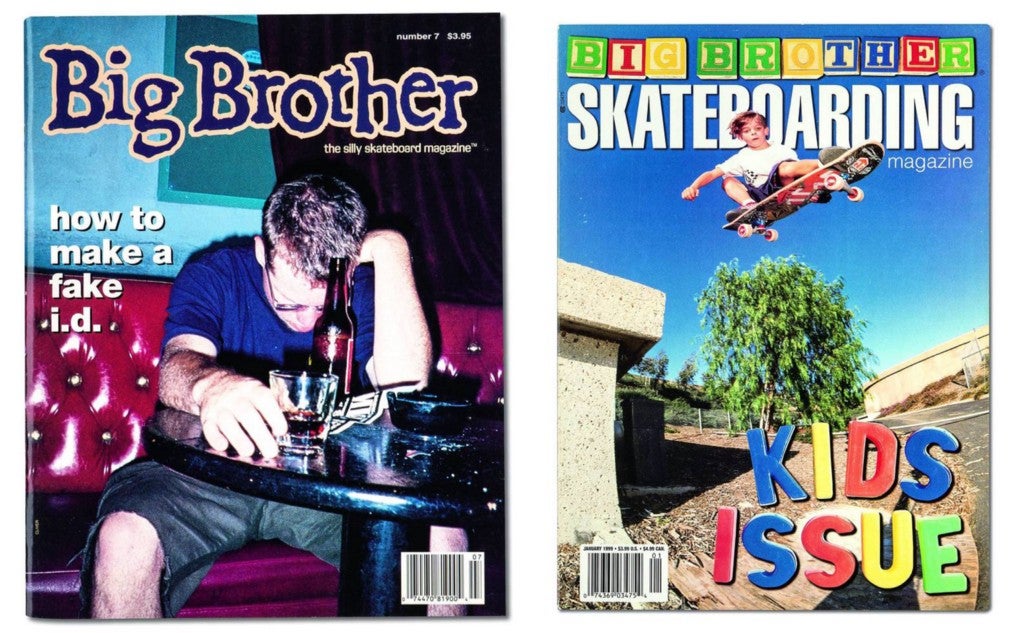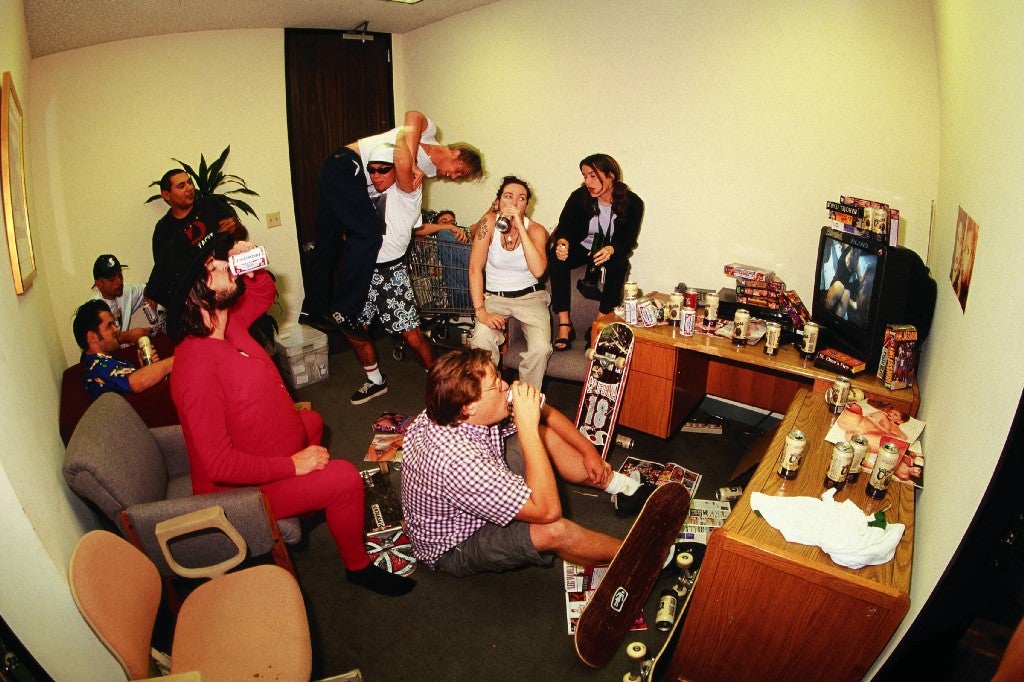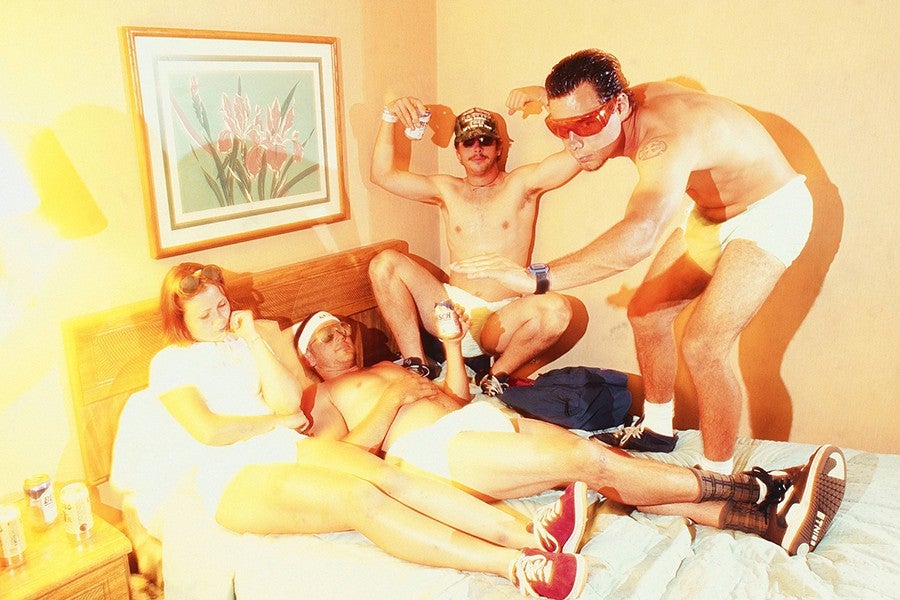If you were a young, restless, antisocial, juvenile creative type in the 1990s, Big Brother probably felt like paradise. An independent magazine that celebrated skateboard culture—and more importantly, its ethos of nose-thumbing, punk-rock rebellion—the publication flaunted its freedom, crudeness and irreverence, serving as a virtual boys’ club of snotty humor and locker-room shenanigans. The overgrown man-children who ran Big Brother for 12 years never wanted to be accepted by the mainstream and were ecstatic when they pissed off conservative watchdogs. But as a new documentary suggests, these men, responsible for objectionable articles about how to commit suicide and buy crack, ended up paving the way for genuine outsider art — almost despite themselves.
Dumb: The Story of Big Brother Magazine, which just premiered on Hulu, is a fairly straightforward, oral-history recounting of the origins of the Southern California publication, which emerged in 1992 as a naughty response to the more corporate skateboarding magazines Transworld and Thrasher, letting fly with plenty of F-bombs and sexually explicit content. Director Patrick O’Dell gathers a lot of the old editorial team — including founder Steve Rocco and onetime editor Sean Cliver — to rhapsodize about the early days, and the film’s stick-it-to-the-man spirit is established by an opening title card that quotes George Orwell’s famous line: “Journalism is printing what someone else does not want printed; everything else is public relations.” But Dumb (like the publication’s brain trust) oversells precisely what was transgressive about Big Brother. The magazine wasn’t speaking truth to power or challenging cultural norms. These guys — and it was almost entirely guys — were brats testing how far they could push their outrageous antics. It wasn’t noble or high-minded; it was a willful, anarchic goof.
It’s hard to watch Dumb and not experience the conflicting feelings that get stirred up whenever a controversial figure like Larry Flynt, 2 Live Crew or, more recently, Kathy Griffin gets dragged into society’s crosshairs. On the one hand, you want to support their right to push the boundaries of free speech. On the other, do you really want to spend time defending work that’s often witless and sophomoric?

Big Brother, which was later purchased by Flynt, was First Amendment problematic in its own way. Dumb makes a compelling case for the seat-of-the-pants enthusiasm that Rocco and his cohorts embraced while dreaming up a new kind of skateboard magazine. Each issue would be its own separate entity, switching out logos and even basic design elements so that the magazine never looked the same. What remained consistent was a proudly lo-fi aesthetic that made Big Brother feel like a slightly more polished zine with a ton of nudity, poop jokes and instructions for how to make a fake ID.
“They were covering hardcore skating, but also guys drinking and smoking and partying,” celebrity skateboarder Tony Hawk says in Dumb. “I guess it was more in tune with what skating was back then.” Where other skateboard magazines merely touted cool moves and new products, Big Brother appealed directly to the scene’s underlying bro-heavy vibe. As someone explains in Dumb, “These guys were all just delinquents. … It was really cool to see, like, all the other sides of skaters — no matter how rotten it was.”
From a sociological perspective, Big Brother provides a fascinating time capsule of a certain kind of immature, smart-ass dude — the sort who, in another generation, might have really dug Mad or National Lampoon. Dumb wisely pinpoints Big Brother’s ascendance as the period right before the internet took over the world, a forgotten age in which young, horny dudes had to hunt down dirty magazines and cheap VHS tapes in order to see porn. Back then, subcultures still felt like cool little secrets, long before the web would make them so much more easily accessible—stripping them of their scruffy cachet.

“Big Brother was really never about skateboarding,” former editor Jeff Tremaine admits. “We really hid behind skateboarding to just make this ridiculous magazine of just stupid shit we want to do.” That included hanging out with Slayer at Disneyland or venturing to New Orleans to drink and see boobs — all the while crudely filming their escapades on low-budget camcorders.
Quickly, others became inspired to do their own kamikaze stunt videos. One of them was Johnny Knoxville, an aspiring actor who had recently moved to L.A. from Tennessee. Knoxville didn’t care about skateboarding, but he loved Big Brother’s let’s-wreck-shit attitude, which inspired him to record hidden-camera bits — like, for instance, when he tried to send back his sausage in a restaurant, clandestinely replacing the link with a turd to freak out the waitress. Or he’d test out different self-defense items—such as a taser, pepper spray and a bulletproof vest—by shooting himself at close range. It was the same riotous, adolescent spirit that Big Brother championed, but with his good looks and magnetic personality, Knoxville brought a star power the magazine and its lovable weirdos had never known.
“When he came back with these tapes, it was so compelling,” Tremaine says in Dumb, recalling his introduction to the man who would soon change his life. “Knoxville could talk to the camera — he was the first guy that we had that could actually talk on camera.” Recruiting some of the Big Brother squad, including a lunatic dwarf named Wee Man and a wiry performer who went by Steve-O, Tremaine, Knoxville and future Oscar-winning filmmaker Spike Jonze (who shot the magazine’s very first cover photo) developed the concept for a reality show dominated by similarly ridiculous stunts and pranks. The launch of Jackass on MTV in 2000 resulted in four hit films and a growing critical appreciation for the sophistication beneath the franchise’s slapstick brutality, leading to 2000’s Jackass 3D premiering at New York’s Museum of Modern Art.
In many ways, Jackass became the incisive societal critique that Big Brother was too belligerent to articulate. Where the magazine (which closed its doors in 2004) was all raucous acting-out, the series found a deeper level to its mischief, commenting on male-bonding rituals and guys’ fascination with physical pain amidst the gut-turning scatological pranks and death-defying stunts.
“Humor didn’t feel dangerous until I picked up Big Brother,” Jonah Hill says near the end of Dumb. “…I felt that humor could be cool, because it could be dangerous and make people uncomfortable.” Jackass translated the written and photographic provocations of Big Brother and made it far more visceral, hilarious and weirdly profound. Dumb is meant to honor Big Brother’s legacy, but the documentary ends up arguing that, of all the magazine’s shocking incitements, the birth of something as brilliant as Jackass was its most revolutionary — and unlikely.

